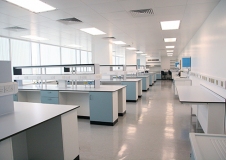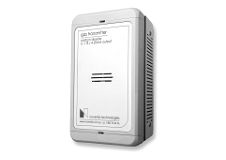Laboratory and Medical Gas Detection
Research and academia applications can have a range of gases which require continuous monitoring such as natural gas, oxygen and carbon dioxide.
Asphyxiant gases are very common in laboratories; these are gases which are non-or minimally toxic but can dilute the oxygen in air, leading to unconsciousness or death if breathed long enough. Because asphyxiant gases are relatively inert, their presence in large quantities may not be noticed until the effects of elevated carbon dioxide in blood are recognised by the body. Examples of asphyxiant gases are nitrogen, argon and helium. Asphyxiation can also occur due to high volumes of other toxic gases as well as Methane.
Another category of risk posed by gases used in laboratories is the explosion/flammability risk. Gases are typically stored in pressurised cylinders, and improper handling can lead to cylinder damage with sudden pressure discharge and explosions. Any small spark from electrical equipment or hot surfaces can be sufficient to trigger a fire. Furthermore certain gases also pose a toxic hazard for example, Carbon Monoxide (CO) and Nitrous Oxide (N2O).
Equipment and personnel must therefore be protected against combustible, toxic and flammable gases and asphyxiation at all times. Any laboratory using inert gases such as argon, nitrogen or helium as carrier gases or in cryogenics need to consider some sort of gas detection. More information about laboratory gas detection, follow the links below.
- CO2 Detection Using an Oxygen Detector?
- Effects of Oxygen Depletion / Enrichment
- Potential Hazards
- Documents and References
CO2 Detection Using an Oxygen Detector?
A common misunderstanding is using an Oxygen detector to detect leaks of Carbon Dioxide. To illustrate the risk doing so, please refer to the table below.
| CO2 | Oxygen | Nitrogen | Other Gases |
|---|---|---|---|
| 0% | 21.00% | 78.00% | 1% |
| 1% | 20.80% | 77.20% | 1% |
| 2% | 20.60% | 76.40% | 1% |
| 3% | 20.40% | 75.70% | 1% |
| 4% | 20.20% | 74.90% | 1% |
| 5% | 20.00% | 74.10% | 1% |
| 6% | 19.70% | 73.30% | 0.90% |
| 7% | 19.50% | 72.50% | 0.90% |
| 8% | 19.30% | 71.80% | 0.90% |
| 9% | 19.10% | 71.00% | 0.90% |
| 10% | 18.90% | 70.20% | 0.90% |
As an example, the pre warning level (TWA) for CO2 is 0.5%. An Oxygen detector would alarm as per Australian standards at 19.5% volume; this would represent a CO2 level of over 7% !! No need to explain the potential risk associated using an Oxygen detector for detection of CO2.
Effects of Oxygen Depletion / Enrichment
Oxygen detectors usually provide a first-level alarm when the oxygen concentration has dropped to 19.5% volume. Most people will begin to behave abnormally when the level reaches 17.5%, and hence a second alarm is usually set at this threshold. Exposure to atmospheres containing between 10% and 13% oxygen can bring about unconsciousness very rapidly; death comes very quickly if the oxygen level drops below 6% volume.
Increased levels of oxygen (Oxygen Enrichment) may dramatically increase the flammability of any combustible matter. The risk from oxygen enrichment exists where pure oxygen is stored; for example in hospitals and gas manufacturing plants. Very high Oxygen levels over 50% will lead to brain damage.
Potential Hazards
- Carbon Monoxide
- Asphyxiation from nitrogen, argon and helium
- Methane and other combustible gases
- Toxic gases for sterilisation
- Volatile organic compounds
- Other Pyrophoric gases such as Silane, Phosphine, Arsine
Documents and References
- AS 1596-2008: The storage and handling of LP Gas
- AS 2243.6-2010: Safety in laboratories Part 6
- AS 2243.10-2004: Safety in laboratories Part 10
- AS 4332-2004: The storage and handling of gases in cylinders
- AS 4641-2018: Electrical apparatus for detection of oxygen and other gases & vapours - Gen. Requirements
- AS 60079.10.1-2009: Explosive atmospheres
- Safe Work Australia – Hazardous Substances Information System



